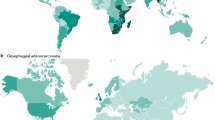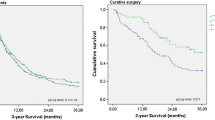Abstract
Oesophageal cancer is a disease of dismal prognosis. There are variations of epidemiology among different ethnic groups and geographic regions. India is a country with high incidence. This can be attributed to the interplay between environmental, dietary factors and life-style of the population of the country. Optimal therapeutic strategy for patients with oesophageal cancer demands individual consideration.
Majority of oesophageal cancer patients present at an advanced stage of disease. Screening programmes or strategies aiming at early diagnosis can improve the prognosis; unfortunately this is not cost-effective except in very high incidence areas. Accurate staging can help select the most appropriate treatments, such as excluding those patients with metastatic disease who are unlikely to benefit from surgery, and treating very early lesions with endoscopic means. When surgery is indicated, treating patient in a high-volume centre can improve the outcome and minimise complications. Although surgical resection remains the main treatment modality, long-term prognosis after surgical resection alone has been suboptimal except in those with early disease. Multidisciplinary approaches including chemotherapy and radiotherapy with or without surgery are increasingly employed for patients with advanced disease. Collaboration among surgeons, clinical oncologists, radiologists and physicians is of utmost importance to achieve the best results. Treatment for patients should be individualised to enhance outcome.
Similar content being viewed by others
References
Parkin DM, Bray F, Ferlay J, Pisani P (2005) Global cancer statistics, 2002. CA Cancer J Clin 55:74–108
Gupta NM, Jindal R, Prakash O, Gupta R, Bhasin DK (2001) Comparison of the clinical profile and outcome for squamous cell carcinoma and adenocarcinoma of the distal esophagus and cardia in India. Surg Today 31:400–404
Devesa SS, Blot WJ, Fraumeni JF Jr (1998) Changing patterns in the incidence of esophageal and gastric carcinoma in the United States. Cancer 83:2049–2053
Law S, Wong J (2002) Changing disease burden and management issues for esophageal cancer in the Asia-Pacific region. J Gastroenterol Hepatol 17:374–381
Peters JH, Hagen JA, DeMeester SR (2004) Barrett’s esophagus. J Gastrointest Surg 8:1–17
Graham DY (2003) The changing epidemiology of GERD: Geography and Helicobacter pylori. Am J Gastroenterol 98:1462–1470
Cherian JV, Sivaraman R, Muthusamy AK, Jayanthi V (2007) Carcinoma of the esophagus in Tamil Nadu (South India): 16-year trends from a tertiary center. J Gastrointestin Liver Dis 16:245–249
Li L, Lu F, Zhang S (1996) Analysis of cancer modality and distribution in China from year 1990 through 1992- an epidemiologic study. Zhonghua Zhong Liu Za Zhi 18:403–407
He YT, Hou J, Qiao CY, et al. (2003) An analysis of esophageal cancer incidence in Cixian county from 1974 to 1996. World J Gastroenterol 9:209–213
Gao H, Wang LD, Zhou Q, Hong JY, Huang TY, Yang CS (1994) p53 tumour suppressor gene mutation in early esophageal precancerous lesions and carcinoma among highrisk populations in Henan, China. Cancer Res 54:4342–4346
Li MH, Li P, Li PJ (1980) Recent progress in research on esophageal cancer in China. Adv Cancer Res 33:173–249
Phukan RK, Ali MS, Chetia CK, Mahanta J (2001) Betel nut and tobacco chewing; potential risk factors of cancer of oesophagus in Assam, India. Br J Cancer 85:661–667
Khuroo MS, Zargar SA, Mahajan R, Banday MA (1992) High incidence of oesophageal and gastric cancer in Kashmir in a population with special personal and dietary habits. Gut 33:11–15
Lee CH, Lee JM, Wu DC, et al. (2005) Independent and combined effects of alcohol intake, tobacco smoking and betel quid chewing on the risk of esophageal cancer in Taiwan. Int J Cancer 113:475–482
Murtaza I, Mushtaq D, Margoob MA, et al. (2006) A study on p53 gene alterations in esophageal squamous cell carcinoma and their correlation to common dietary risk factors among population of the Kashmir valley. World J Gastroenterol 12:4033–4037
Chitra S, Ashok L, Anand L, Srinivasan V, Jayanthi V (2004) Risk factors for esophageal cancer in Coimbatore, southern India: a hospital-based case-control study. Indian J Gastroenterol 23:19–21
Dawsey SM, Shen Q, Nieberg RK, et al. (1997) Studies of esophageal balloon cytology in Linxian, China. Cancer Epidemiol Biomarkers Prev 6:121–130
Nabeya K, Hanaoka T, Onozawa K, Ri S, Nyumura T, Kaku C (1990) Early diagnosis of esophageal cancer. Hepatogastroenterology 37:368–370
Wang GQ, Jiao GG, Chang FB, et al. (2004) Long-term results of operation for 420 patients with early squamous cell esophageal carcinoma discovered by screening. Ann Thorac Surg 77:1740–1744
Peters JH, Clark GW, Ireland AP, Chandrasoma P, Smyrk TC, DeMeester TR (1994) Outcome of adenocarcinoma arising in Barrett’s esophagus in endoscopically surveyed and nonsurveyed patients. J Thorac Cardiovasc Surg 108: 813–821
American Joint Committee on Cancer (2009) Esophagus. In: AJCC Cancer Staging Manual. Springer Verlag, New York
Rosch T (1995) Endosonographic staging of esophageal cancer: a review of literature results. Gastrointest Endosc Clin N Am 5:537–547
Reed CE, Mishra G, Sahai AV, Hoffman BJ, Hawes RH (1999) Esophageal cancer staging: improved accuracy by endoscopic ultrasound of celiac lymph nodes. Ann Thorac Surg 67:319–321
Luketich JD, Schauer PR, Melttumourr CC, et al. (1997) Role of positron emission tomography in staging esophageal cancer. Ann Thorac Surg 64:765–769
Flamen P, Lerut A, Van Cutsem E, et al. (2000) Utility of positron emission tomography for the staging of patients with potentially operable esophageal carcinoma. J Clin Oncol 18:3202–3210
Lerut T, Flamen P, Ectors N, et al. (2000) Histopathologic validation of lymph node staging with FDG-PET scan in cancer of the esophagus and gastroesophageal junction: A prospective study based on primary surgery with extensive lymphadenectomy. Ann Surg 232:743–752
Luketich JD, Friedman DM, Weigel TL, et al. (1999) Evaluation of distant metastases in esophageal cancer: 100 consecutive positron emission tomography scans. Ann Thorac Surg 68:1133–1136
Swisher SG, Maish M, Erasmus JJ, et al. (2004) Utility of PET, CT, and EUS to identify pathologic responders in esophageal cancer. Ann Thorac Surg 78:1152–1160
Earlam R, Cunha-Melo JR (1980) Oesophageal squamous cell carcinoma: I. A critical review of surgery. Br J Surg 67:381–390
Muller JM, Erasmi H, Stelzner M, Zieren U, Pichlmaier H (1990) Surgical therapy of oesophageal carcinoma. Br J Surg 77:845–857
Birkmeyer JD, Siewers AE, Finlayson EV, et al. (2002) Hospital volume and surgical mortality in the United States. N Engl J Med 346:1128–1137
Birkmeyer JD, Stukel TA, Siewers AE, Goodney PP, Wennberg DE, Lucas FL (2003) Surgeon volume and operative mortality in the United States. N Engl J Med 349:2117–2127
Law S, Kwong DL, Kwok KF, et al. (2003) Improvement in treatment results and long-term survival of patients with esophageal cancer: impact of chemoradiation and change in treatment strategy. Ann Surg 238:339–347
Altorki N, Kent M, Ferrara C, Port J (2002) Three-field lymph node dissection for squamous cell and adenocarcinoma of the esophagus. Ann Surg 236:177–183
Ando N, Ozawa S, Kitagawa Y, Shinozawa Y, Kitajima M (2000) Improvement in the results of surgical treatment of advanced squamous esophageal carcinoma during 15 consecutive years. Ann Surg 232:225–232
Siewert JR, Stein HJ, Feith M, Bruecher BL, Bartels H, Fink U (2001) Histologic tumour type is an independent prognostic parameter in esophageal cancer: Lessons from more than 1,000 consecutive resections at a single center in the Western world. Ann Surg 234:360–367
Wouters MW, Karim-Kos HE, le Cessie S, et al. (2009) Centralization of esophageal cancer surgery: does it improve clinical outcome? Ann Surg Oncol 16:1789-1798
Lagarde SM, Maris AK, de Castro SM, Busch OR, Obertop H, van Lanschot JJ (2007) Evaluation of O-POSSUM in predicting in-hospital mortality after resection for oesophageal cancer. Br J Surg 94:1521–1526
Law SY, Fok M, Wong J (1994) Risk analysis in resection of squamous cell carcinoma of the esophagus. World J Surg 18:339–346
Law S, Wong KH, Kwok KF, Chu KM, Wong J (2004) Predictive factors for postoperative pulmonary complications and mortality after esophagectomy for cancer. Ann Surg 240:791–800
Bartels H, Stein HJ, Siewert JR (1998) Preoperative risk analysis and postoperative mortality of oesophagectomy for resectable oesophageal cancer. Br J Surg 85:840–844
Orringer MB, Marshall B, Iannettoni MD (1999) Transhiatal esophagectomy: clinical experience and refinements. Ann Surg 230:392–400
Katariya K, Harvey JC, Pina E, Beattie EJ (1994) Complications of transhiatal esophagectomy. J Surg Oncol 57:157–163
Omloo JM, Lagarde SM, Hulscher JB, et al. (2007) Extended transthoracic resection compared with limited transhiatal resection for adenocarcinoma of the mid/distal esophagus: five-year survival of a randomised clinical trial. Ann Surg 246:992–1000
Cuschieri A, Shimi S, Banting S (1992) Endoscopic oesophagectomy through a right thoracoscopic approach. J R Coll Surg Edinb 37:7–11
Qureshi I, Nason KS, Luketich JD (2008) Is minimally invasive esophagectomy indicated for cancer? Expert Rev Anticancer Ther 8:1449–1460
Law SY, Fok M, Wei WI, et al. (2000) Thoracoscopic esophageal mobilization for pharyngolaryngoesophagectomy. Ann Thorac Surg 70:418–422
Osugi H, Takemura M, Higashino M, Takada N, Lee S, Kinoshita H (2003) A comparison of video-assisted thoracoscopic oesophagectomy and radical lymph node dissection for squamous cell cancer of the oesophagus with open operation. Br J Surg 90:108–113
Smithers BM, Gotley DC, McEwan D, Martin I, Bessell J, Doyle L (2001) Thoracoscopic mobilization of the esophagus. A 6 year experience. Surg Endosc 15:176–182
Law S, Fok M, Chu KM, Wong J (1997) Thoracoscopic esophagectomy for esophageal cancer. Surgery 122:8–14
Osugi H, Takemura M, Higashino M, et al. (2003) Learning curve of video-assisted thoracoscopic esophagectomy and extensive lymphadenectomy for squamous cell cancer of the thoracic esophagus and results. Surg Endosc 17: 515–519
Akiyama H, Tsurumaru M, Udagawa H, Kajiyama Y (1994) Radical lymph node dissection for cancer of the thoracic esophagus. Ann Surg 220:364–372
Peyre CG, Hagen JA, DeMeester SR, et al. (2008) The number of lymph nodes removed predicts survival in esophageal cancer: an international study on the impact of extent of surgical resection. Ann Surg 248:549–556
Rizk NP, Ishwaran H, Rice T, Chen LQ, Schipper P et al. (2009) Optimum lymphadenectomy for esophageal cancer. Ann Surg (In-press)
Medical Research Council Oesophageal Cancer Working Party (2002) Surgical resection with or without preoperative chemotherapy in oesophageal cancer: a randomized controlled trial. Lancet 359(9319): 1727–1733
Petrasch S, Welt A, Reinacher A, Graeven U, Konig M, Schmiegel W (1998) Chemotherapy with cisplatin and paclitaxel in patients with locally advanced, recurrent or metastatic oesophageal cancer. Br J Cancer 78:511–514
Kok TC, Kerfhofs L, et al. (1998) Biweekly administration of cisplatin and increasing doses of paclitaxel in patients with advanced esophageal cancer. Proc Am Soc Clin Oncol 17 (Abstract 997)
Herskovic A, Martz K, al-Sarraf M, et al. (1992) Combined chemotherapy and radiotherapy compared with radiotherapy alone in patients with cancer of the esophagus. N Engl J Med 326:1593–1598
Cooper JS, Guo MD, Herskovic A, et al. (1999) Chemoradiotherapy of locally advanced esophageal cancer: long-term follow-up of a prospective randomised trial (RTOG 85-01). Radiation Therapy Oncology Group. JAMA 281:1623–1627
Law S, Wong J (2005) Current management of esophageal cancer. J Gastrointest Surg 9:291–310
Baron TH (2001) Expandable metal stents for the treatment of cancerous obstruction of the gastrointestinal tract. N Engl J Med 344:1681–1687
Author information
Authors and Affiliations
Corresponding author
Rights and permissions
About this article
Cite this article
Tong, D.K.H., Law, S. Management of oesophageal cancer. Indian J Surg 71, 317–325 (2009). https://doi.org/10.1007/s12262-009-0087-3
Received:
Accepted:
Published:
Issue Date:
DOI: https://doi.org/10.1007/s12262-009-0087-3




